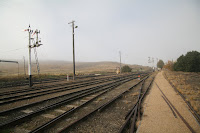Cooma railway station and yard, was opened in 1889. The railway station was officially closed in 1988 with the SRA disposing of the site due to closing down the entire Bombala rail branch line.
Cooma was one of the main stations on the Bombala line as it served the Snowy Mountains system and had much passenger and goods traffic up until closure. The layout of the station was designed to have all the required train infrastructure closely located.
The Station and platform is served with 2 dock roads , 1 at each end which were used by railmotors, carriages, goods wagons and locomotives at various times for storage/loading.
The goods shed is located to the north and was built to handle much goods transhipment.
The locomotive shed and water tank were close together ( as was a coal stage) to provide servicing for the steam locomotives.
A loco building and a turntable were next to the locomotive shed and finally a barrack quarters for crews to relax and sleep at was found opposite the station.
Extensive points, switches, signalling and track is found within the yard.
In the early 1990s a local preservation group - Cooma Monaro Railway - became interested in saving the railway infrastructure and over the years has grown from a small group to a major tourism business using operational train rides as an attraction. Visit the their webpage for more information - http://www.cmrailway.org.au
The CMR has restored and lease the railway line up to Chakloa which is 20km away from town.
Unfortunately the CMR cant go any further than this as a railway bridge is damaged and cant be cheaply fixed any time soon by a volunteer group.
The CMR are seen running on a weekly schedule the famous 1920s era CPH railmotors - which they own 4 of - in superb condition after extensive restorations. This tourism / train travels earns the town of Cooma a reported $4m a year spent in extra visits. At times up to 4 busloads a week of people travel on the CPH railmotors in the seasonal busy periods.
While at the museum i ran into a volunteer who had come down from Sydney for his first day at work. That is dedication to the railway heritage scene.
It would be nice to one day see the Cooma branch line reopened back to Canberra again but that is basically unlikely to ever happen due to a lack of federal and state government willingness to rebuild the railway line. Seems the politicians running Australia dont see the "return value" in rebuilding the railway lines to southern NSW and thus restarting long lost art of railway travel. The other big benefit would be that tourism money spent from domestic and international visitors coming by train would flow through on to the towns helping jobs and helping some towns to stay alive.
STATION BUILDING / PLATFORM
Various views of the platform, dock sidings, station features and operational areas


































LOCOMOTIVE SHED









LOCO BARRACK


TURNTABLE






CREW BARRACK





GOODS SHED




MUSEUM DISPLAYS
This railway model display is a detailed recreation of sections of the Goulburn to Bombala branch with some very realistically recreated scenes.













COOMA YARD

















YARD SIGNALS AND POINTS








CPH RAILMOTORS IN LOCOMOTIVE SHED






























S TRUCK GOODS WAGON


TRIKES AND TRACK MACHINES



VOLUNTEERS - these are the people who run the CMR, hard working, dedicated and long term railway enthusiasts who want to see the NSWGR era not forgotten at Cooma. One of these people came from Sydney just to spend time at Cooma helping out on the day i arrived. This shows how far Cooma railway heritage and operations popualrity can extend to.


NEXT BLOG STORY - COMING SOON
After a good look around at the Cooma-Monaro Railway museum / yard and thanking the kind volunteers, i departed for a 2hr drive, to attend a quite rare event not often seen in NSW in this modern era - at Tumut , a reopening of a once closed railway station and yard for community purposes.
This was an event i was invited to attend by showing interest in railway history. At the event i managed to talk to a wide variety of people such as a federal politican, the shire mayor, hard working project volunteers and the local residents - all who were quite happy to see their local history preserved.
Photos and information coming soon.